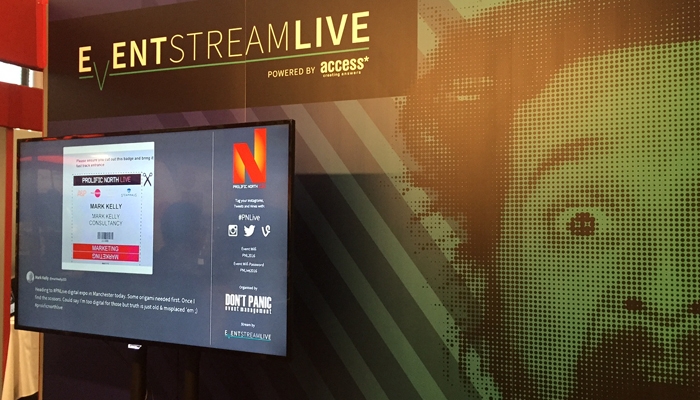
Having just attended Prolific North’s first exhibition, Prolific North Live, we’re buzzing with ideas on how to improve your social media presence when attending a conference or exhibitor’s show.
Amongst the conversations had between delegates on stalls and over coffee, a much bigger conversation was happening online; Prolific North Live’s jumbo screens were projecting tweets and posts using EventStreamLive.
Twitter alone saw some incredible results:
- Over 2,250 tweets
- Over 7 million timeline deliveries
- Almost 2 million individual views
- Over 765 unique contributors
- #PNLive trended twice on Twitter in the UK
But how were these numbers achieved? What could your company be doing to engage delegates online at the event and afterwards? Take a look at our quick fire tips to come out on top at your next conference.
1. Pre-event: do your research
It’s so important to know who your audience is going to be and what makes them tick. Go to the event’s website, create a list of exhibitors and get under their online skin. What do they regularly re-post or tweet? What kind of content are they most likely to share? How active are they? Having this bank of data behind your event plan is fantastic for post event contact as well as during the show.
It’s also important to think about who your delegates are going to be. Do the same research for them and think about how to utilise it during the event. Your research is a key part of your decision making process – have it inform your event strategy.
2. During the event: Thank the people you talk to
If someone visits your stall ask them for their Twitter handle, follow them, and then thank them for stopping by. They could re-tweet your thank you, helping you to raise your profile at the event and help you to become part of the bigger conversation.
3. During the event: Share your own activity
It’s important to talk to people at the event – but it’s also vital to inform people about your own activity. Your product of service is why you’re there – post pictures when you get busy, mention people that appear in the photo with you and be sure to use the event’s hashtag to help with the visibility of your post.
4. During the event: Think about your content types
It’s great to vary up your feed during the event so people are constantly reading your posts or tweets. Post slow motion-capture video or you could post photos of people you’ve met at the event, mentioning them to re-tweet. Anything that involves a more active response is great – a video post lasting under a minute, for example, enjoys an 80% retention rate from viewers.*

5. Post Event: Analyse your social success
Analysing where you’ve excelled or fallen down during a live event is a great way to inform your decisions for your next event. However, before you go delving into your statistics, talk as a team where you feel you did really well – then see if your data supports your team’s feeling. If there’s a divide between how you feel it went and what your data says then discuss why this might be. Create a plan for your next event and refine your process.
Social media superstars from #PNLive
There were some real standout social media efforts from participants at Prolific North Live – our social media enthusiast, Lauren, gives her top 3:
Great engagement came from their blackboard feature wall. People were encouraged to share turns of phrase that all agencies are guilty of and tweet their addition – it worked on us!
Seconds That Count Studios - @STCStudios
Seconds That Count nailed their pre-event engagement, their Twitter feed turned into their own PR machine – you were sure to know about the event if you were following them!
The Sharp Project - @sharpproject
Fantastic event participation and some really interesting content came flooding in from The Sharp Project.
Our 3 Key Takeaways
- Knowing your audience is key. Research their social behaviour before an event and get under their digital skin.
- Keep the conversation going. Don’t ignore people after you’ve just met them – talk to them during and after the event.
- Keep it varied. Post different kinds of content, ensuring your users won’t get bored of your posts.








